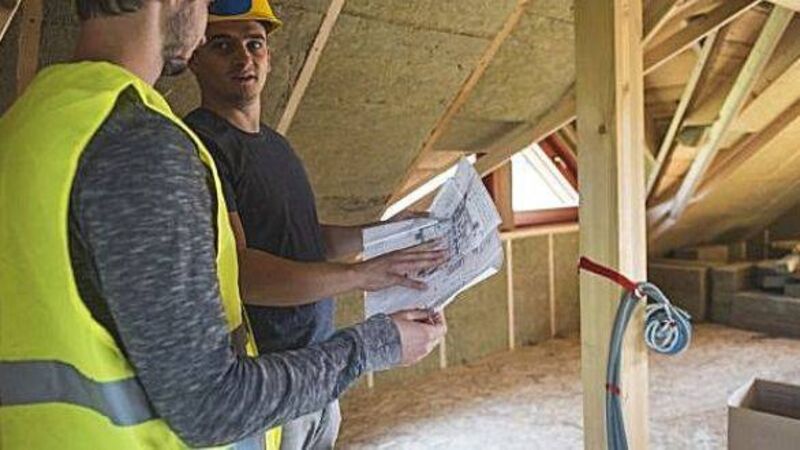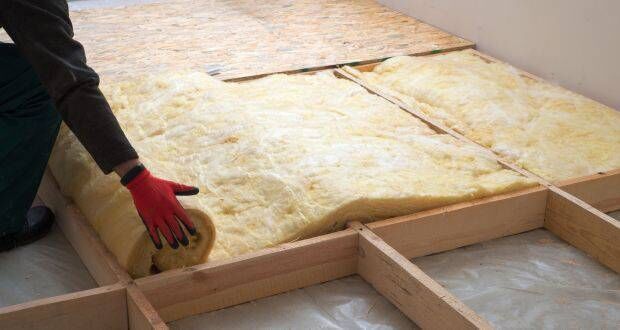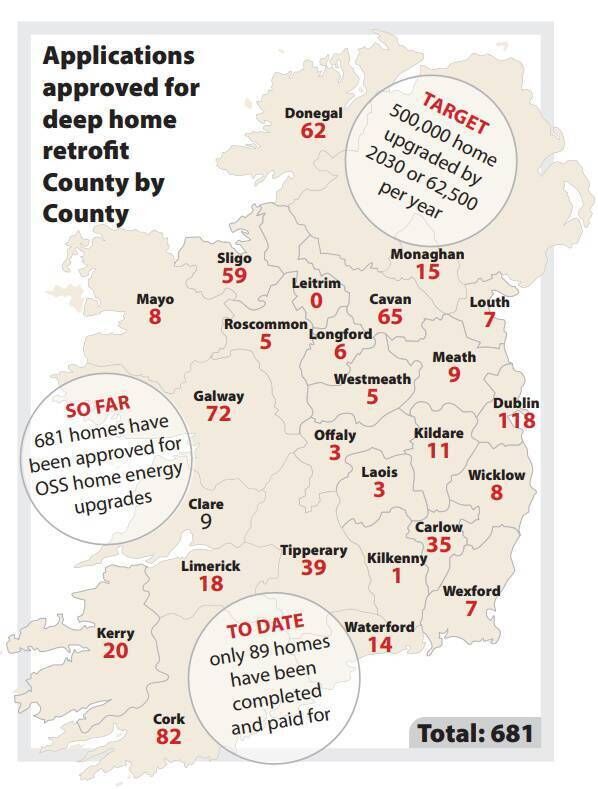Scheme branded a 'failure' with just 89 homes retrofitted out of target of 62,500

SEAI estimates that the cost of a one-stop shop (OSS) deep home retrofit ranges from €12,600 to €79,000, with a reported average total cost figure of €29,000. Picture: Getty
The Government’s marquee retrofitting scheme “has utterly failed”, with just 89 homes in the entire country completed out of a “pie in the sky” target of 500,000 homes.
Despite a need to retrofit 62,500 homes this year to remain on target, just 681 homes have so far been approved, it can be revealed.
Take-up of the scheme has been so low that 13 counties have had fewer than 10 applications, with Co Leitrim failing to record a single application.
Launched to much fanfare in February by Green Party leader Eamon Ryan, the National Home Energy Upgrade Scheme offered increased grant levels of up to 50% of the cost of a typical B2 home energy upgrade and was a centrepiece of his plan to improve energy efficiency in Irish homes.

Operated by the Sustainable Energy Authority of Ireland (SEAI), the scheme promised a “hassle-free way to undertake home energy upgrades with one-stop shops providing an end-to-end service for homeowners", but critics have said a lack of contractors, significant upfront costs, and an overly bureaucratic process are proving to be insurmountable barriers.
Figures obtained show that Dublin, with 118, has had the most applications, followed by Cork with 82; Galway next with 72; Sligo with 59, and Tipperary with 39.
Those counties with fewer than 10 applications are: Clare (9); Meath (9); Wicklow (8); Mayo (8); Louth (7); Wexford (7); Longford (6); Westmeath (5); Roscommon (5); Offaly (3); Laois (3); Kilkenny (1); and Leitrim (0).
With the full cost of a retrofit topping €80,000, the requirement to raise half of that is proving too much for families during the current cost-of-living crisis.

Figures show that since February, a total of 89 homes have been completed. Recent figures from the SEAI estimates that the cost of a one-stop shop (OSS) deep home retrofit ranges from €12,600 to €79,000, with a reported average total cost figure of €29,000. The average OSS home energy grant offer is €20,500.
However, it is important to note that these averages may fluctuate depending on the applications submitted to the SEAI.
Defending the delays, Mr Ryan said that because of the use of external third-party firms such as the one-stop shops, the registration process for this new service must be robust.
The OSS is required to secure the consent of the homeowner before applying for the grant. The OSS has to enter into separate contracts with homeowners at the two points of the process.
These contracts will respectively provide that the OSS complete the home energy assessment within 12 months from the date the HEA grant offer issues and complete all home energy upgrade works associated with a property within 12 months of date of the grant offer.
Despite the low take-up of this scheme, the SEAI says over 36,000 applications have been received across all its schemes, and all are experiencing significant levels of demand from homeowners.


Social Democrats energy and climate action spokeswoman Jennifer Whitmore said it is no surprise the scheme is failing, given how it is structured.
“No, I am not shocked the numbers are so low,” she said.
“Headline figures mean nothing, delivery is the key and this government simply doesn’t do delivery,” she added.
Speaking as someone who has retrofitted her house, Ms Whitmore said the process is a “bureaucratic nightmare”, as well as being “way too expensive”.
“It also costs you the amount you will save by dealing with the forms and needing your BER rating done before you apply,” she added.
“People simply do not have the money to fund the upfront cost. They are barely able to stay afloat. The Government needs to examine a way to remove that upfront cost if it wants to rescue this plan.”
Retrofitting the house was a "pain in the arse”, according to Ms Whitmore.
“Our house was very, very cold and we’d have the heating on all the time, which was costing us a fortune,” she said.
As energy prices rise and are compounded with a general cost-of-living crisis, reducing home heating bills is increasingly important for consumers.
So what’s it like to complete this internal house makeover?
“We spent years doing it,” she said of the retrofitting of her Co Wicklow home.
“When we bought the house 10 years ago, we knew we wanted to get the insulation done on it, but we couldn’t afford it at that stage.
Ms Whitmore replaced her boiler, installed energy-efficient radiators, and put internal insulation in the house and the attic, and after two years of work, the retrofit was completed earlier this year.
“It’s incredible,” she said. “It is so much more comfortable. Even in the winter, if you get a sunny day, it just heats up the home and captures it in the house.”
Although the process was worthwhile for her family, Ms Whitmore highlighted the barriers facing people.
She said: “We lived in the house while it was going on.
She said low-interest loans are needed for homeowners to be able to afford the remainder of the cost of retrofitting.
In reaction to the latest statistics highlighting a low completion rate so far this year, she said many people may be waiting until the Government introduces more assistance to homeowners for paying costs that are not covered by grants.
“Even if you could get a low-interest loan out, I don’t think there’s a lot of people in the position of getting a loan on top of their already-crippling mortgages,” she said, adding that rising interest rates may make homeowners think twice before retrofitting.
Home retrofits have not been immune from the ongoing labour shortage in the construction industry also.
Homeowner Damian O'Ceirin told the he had great difficulty finding tradespeople interested in retrofitting his mother’s house.
While some got back to him with quotes, many favoured work on the Warmer Homes Scheme, where the Government pays the contractors directly and in full, which is preferred to partial payments and loans under the National Home Energy Upgrade Scheme.
Both Mr O'Ceirin and others speaking to the said the prices they were quoted seemed to be inflated under the SEAI scheme, with some contractors quoting twice the price of work quoted independently of Government schemes.
If implemented in full, the Environmental Protection Agency projects Ireland’s climate action plan to decrease home heating emissions by 44% this decade.
Under the Government’s National Retrofit Plan, 500,000 homes are aimed to be retrofitted and reach a Building Energy Rating of B2 by 2030, but new figures reveal energy upgrade works have been completed and paid for in just 89 homes since February.
It is also hoped that more than 400,000 heat pumps will replace less efficient heating systems by the end of the decade.
CLIMATE & SUSTAINABILITY HUB












